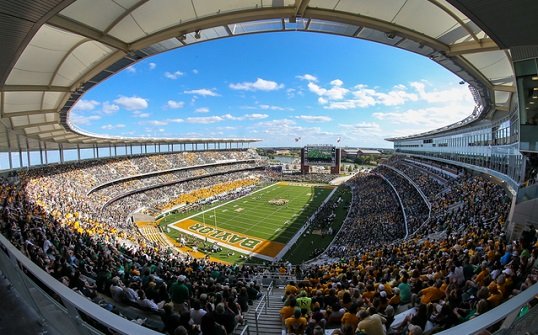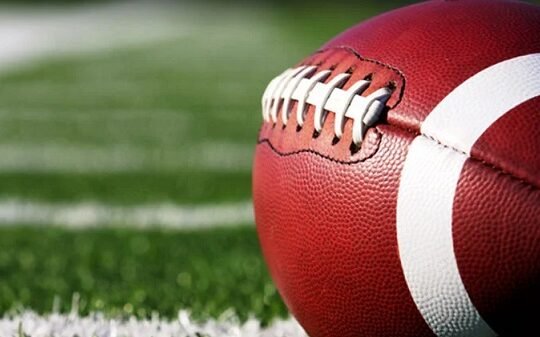In high school football games, the standard football used is the same as in college and professional games. It’s typically an official size and weight football approved by the National Federation of State High School Associations (NFHS). These footballs are made of leather and have specific dimensions and inflation requirements set by the NFHS to ensure consistency and fairness across all high school football competitions.
The NFHS specifies the size, weight, and inflation pressure of footballs to be used in high school games to maintain a level playing field and ensure player safety. The standard football used in high school games is regulation size, which is slightly smaller than NFL footballs but larger than youth footballs. This size is optimal for high school players, balancing grip, control, and throwing accuracy.
NFHS Graphic Markings
NFHS (National Federation of State High School Associations) provides guidelines for graphic markings on high school football fields. These markings are essential for clarity in gameplay and adherence to standard regulations. Here’s an overview of the NFHS graphic markings typically found on high school football fields:
- Yard Lines: NFHS mandates that yard lines be marked every five yards across the width of the field. These yard lines help players, coaches, officials, and spectators track the progress of the ball and the position of the offense and defense during gameplay.
- Hash Marks: Hash marks are shorter lines perpendicular to the yard lines and are typically placed every yard across the width of the field. NFHS regulations specify the distance between hash marks, which varies depending on the width of the field. Hash marks are crucial for determining the placement of the ball between plays, particularly after incompletions or when the ball carrier is tackled inbounds.
- Goal Lines and End Zones: NFHS requires clear markings for the goal lines at each end of the field. Additionally, end zones must be delineated behind each goal line. These markings help players and officials identify scoring opportunities and determine when a player has crossed into the end zone for a touchdown.
- Field Numbers and Team Bench Areas: NFHS regulations often require field numbers to be marked at various locations on the field to aid in communication and player identification. Additionally, designated team bench areas are typically marked along the sidelines to provide space for players, coaches, and personnel during the game.
- Restricted Areas: NFHS may specify restricted areas on the sidelines or end zones where only authorized personnel, such as coaches, players, and officials, are allowed. These markings help maintain order and safety during the game by preventing unauthorized individuals from accessing certain areas of the field.
- Coaches’ Boxes and Player Boxes: NFHS regulations may include markings for coaches’ boxes and player boxes along the sidelines. These designated areas provide space for coaches and players to stand during the game while minimizing interference with on-field activities and officials.
GST football
The GST football, manufactured by Wilson Sporting Goods, is a popular choice for high school football games. The GST (or “Game Saving Technology”) football is designed with high school and collegiate players in mind, offering advanced features to enhance performance and durability.
The GST football features Wilson’s patented Accurate Control Lacing (ACL) system, which provides a larger surface area for grip and control, allowing players to maintain better ball handling in various weather conditions. This technology helps quarterbacks, receivers, and ball carriers maintain control of the ball, reducing fumbles and improving overall performance on the field
High school football NFHS regulation
high school football, the regulations set by the National Federation of State High School Associations (NFHS) govern various aspects of the game, including rules, equipment, and safety standards. NFHS regulations ensure consistency and fairness in high school football competitions across the United States. Here’s a summary of some key NFHS regulations for high school football:
Field Dimensions: High school football fields must adhere to NFHS standards, which specify dimensions such as field length, width, and markings. These dimensions ensure uniformity and fairness in gameplay.
Player Equipment: NFHS regulations mandate specific equipment for players, including helmets, shoulder pads, mouthguards, and other protective gear. These regulations prioritize player safety and reduce the risk of injuries on the field.
Football Specifications: NFHS sets standards for the size, weight, and inflation pressure of footballs used in high school games. Regulation footballs must meet NFHS specifications to ensure consistency and fairness in gameplay.
Game Rules: NFHS establishes rules governing various aspects of high school football games, including scoring, penalties, timeouts, and game clock management. These rules promote fair play and sportsmanship among players and coaches.
Officials and Officiating: NFHS provides guidelines for the selection, training, and evaluation of football officials who oversee high school games. These officials enforce NFHS rules and ensure that games are conducted safely and fairly.
Player Eligibility: NFHS regulations outline eligibility requirements for high school football players, including academic standards, age limits, and residency rules. These regulations aim to maintain the integrity of high school athletics and prevent unfair advantages.
Safety Protocols: NFHS emphasizes player safety by promoting proper tackling techniques, concussion awareness, heat illness prevention, and emergency action plans. These protocols help minimize the risk of injuries and ensure a safe playing environment for high school football players.
Conclusion
In conclusion, high school football games typically use regulation footballs approved by the National Federation of State High School Associations (NFHS). These footballs adhere to strict standards set by the NFHS regarding size, weight, and inflation pressure to ensure fairness, consistency, and safety across all high school football competitions





